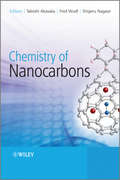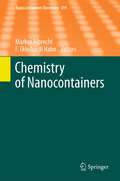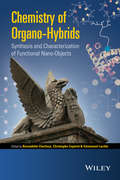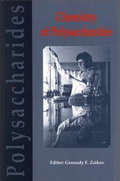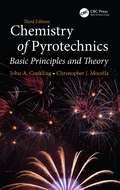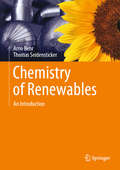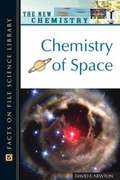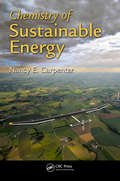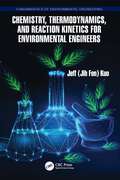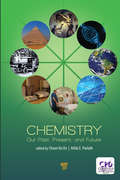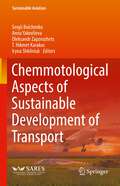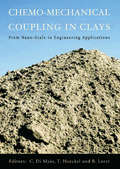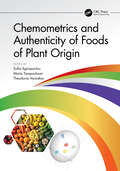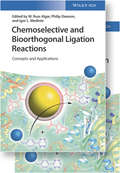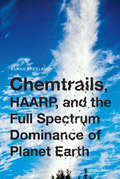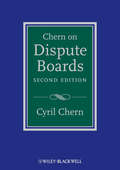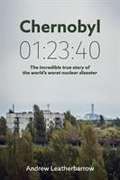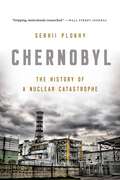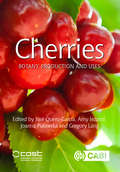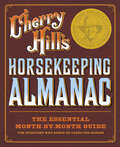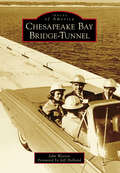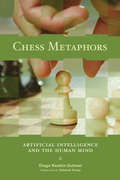- Table View
- List View
Chemistry of Nanocarbons
by Fred Wudl Shigeru Nagase Takeshi AkasakaDuring the last decade, fullerenes and carbon nanotubes have attracted special interest as new nanocarbons with novel properties. Because of their hollow caged structure, they can be used as containers for atoms and molecules, and nanotubes can be used as miniature test-tubes.Chemistry of Nanocarbons presents the most up-to-date research on chemical aspects of nanometer-sized forms of carbon, with emphasis on fullerenes, nanotubes and nanohorns. All modern chemical aspects are mentioned, including noncovalent interactions, supramolecular assembly, dendrimers, nanocomposites, chirality, nanodevices, host-guest interactions, endohedral fullerenes, magnetic resonance imaging, nanodiamond particles and graphene. The book covers experimental and theoretical aspects of nanocarbons, as well as their uses and potential applications, ranging from molecular electronics to biology and medicine.
Chemistry of Nanocontainers (Topics in Current Chemistry #319)
by Markus Albrecht F. Ekkehardt HahnMolecular Cages and Capsules with Functionalized Inner Surfaces, by Stefan Kubik. Drug Delivery by Water-Soluble Organ metallic Cages, by Bruno Therrien. Reversibly Expanded Encapsulation Complexes, by Dariush Ajami und Julius Rebek. Container Molecules Based on Imine Type Ligands, by A. Carina Schulze und Iris M. Oppel. Molecular Capsules Derived from Resorcin[4]arenes by Metal-Coordination, by Tobias Schröder, Satya Narayan Sahu und Jochen Mattay. Coronates, Spherical Containers, Bowl-Shaped Surfaces, Porous 1D-, 2D-, 3D-Metallo-Coordination Polymers, and Metallodendrimers, by Rolf W. Saalfrank und Andreas Scheurer.
Chemistry of Organo-hybrids
by Christophe Coperet Bernadette Charleux Emmanuel LacoteThis book provides readers with a one-stop entry into thechemistry of varied hybrids and applications, from a molecularsynthetic standpoint* Describes introduction and effect of organicstructures on specific support components (carbon-based materials,proteins, metals, and polymers).* Chapters cover hot topics including nanodiamonds,nanocrystals, metal-organic frameworks, peptide bioconjugates, andchemoselective protein modification* Describes analytical techniques, with pros and cons,to validate synthetic strategies* Edited by internationally-recognized chemists fromdifferent backgrounds (synthetic polymer chemistry, inorganicsurfaces and particles, and synthetic organic chemistry) to pulltogether diverse perspectives and approaches
Chemistry of Polymeric Metal Chelates
by Gulzhian I. Dzhardimalieva Igor E. UflyandThis book deals with the chemistry of polymeric metal chelates. The main results and the production and chemical structure of polymers with chelate units as well as the specificity of metal complex binding of different structure are presented here. This book also reveals the transformations which components undergo in the course of chelation. Special attention is paid not only to synthetic but also to natural (including living) systems. The usage of polymeric metal chelates and their development are examined. The related research was performed for chelates with chain structure. This book is useful to researchers being active in synthesis and design of macromolecular metal chelates
Chemistry of Polysaccharides
by Gennady E. ZaikovThis monograph summarizes scientific achievements in the field of polysaccharide chemistry performed in the last decade. The book is intended for wide range of readers: students, post graduates, engineers and scientists engaged in polymer chemistry, organic and physical chemistry.
Chemistry of Pyrotechnics: Basic Principles and Theory, Third Edition
by Chris Mocella John A. ConklingThis book provides chemists with technical insight on pyrotechnics and explosives. It emphasizes basic chemical principles and practical, hands-on knowledge in the preparation of energetic materials. It examines the interactions between and adaptations of pyrotechnics to changing technology in areas such as obscuration science and low-signature flame emission. The updated third edition discusses chemical and pyrotechnic principles, components of high-energy materials, elements of ignition, propagation, and sensitivity. It offers heat compositions, including ignition mixes, delays, thermites, and propellants and investigates the production of smoke and sound as well as light and color.
Chemistry of Renewables: An Introduction
by Arno Behr Thomas SeidenstickerThis textbook introduces the industrial production and processing of natural resources. It is divided into six major topics (fats and oils, carbohydrates, lignin, terpenoids, other natural products, biorefinery), which are divided into a total of 20 chapters.Each chapter is self-contained and therefore a compact learning unit, which can be worked on by students in self-study or presented by lecturers. Clear illustrations, flow diagrams, apparatus drawings and photos facilitate the understanding of the subject matter. All chapters end with a succinct summary, the "Take Home Messages". Each chapter is supplemented by ten short test questions, which can be solved quickly after working through the chapter; the answers are at the end of the book. All chapters contain bibliographical references that focus on essential textbooks and reference works. As a prior knowledge, only basic knowledge of chemistry is required.
Chemistry of Space
by David E. NewtonChemistry of Space provides an overview of the latest information about the solar system, comets, and meteors, and other features of the universe made available as a result of space exploration and research in astrochemistry. The volume is an impressive account of our universe, the events through which it was created, the changes that have taken place during its evolution, and its present composition.
Chemistry of Sustainable Energy
by Nancy E. CarpenterUnderstanding the chemistry underlying sustainable energy is central to any long-term solution to meeting our future energy needs. Chemistry of Sustainable Energy presents chemistry through the lens of several sustainable energy options, demonstrating the breadth and depth of research being carried out to address issues of sustainability and the gl
Chemistry of Water Treatment
by Samuel D. Faust Osman M. AlyThis second edition demonstrates how chemistry influences the design of water treatment plants and how it should influence the design.Historically, water treatment plants have been designed from hydraulic considerations with little regard to chemical aspects. The many chemical reactions used for removal of pollutants from water simply cannot be forced to occur within current designs. This book re-examines this traditional approach in light of today's water quality and treatment.Will current water treatment processes be sufficient to meet future demands or will new processes have to be devised? Chemistry of Water Treatment assesses the chemical and physical efficacies of current processes to meet the demands of the Safe Drinking water Act, providing expert information to persons responsible for the production of potable water into the next century.
Chemistry, Thermodynamics, and Reaction Kinetics for Environmental Engineers (Fundamentals of Environmental Engineering)
by Jeff KuoThis book aims to be the preeminent university chemistry textbook for environmental engineers. It provides undergraduate and graduate environmental engineering students with basic concepts and practical knowledge about chemistry that they would need in their professional careers. It focuses on the fundamental concepts of chemistry and its practical applications (e.g., understanding fate and transport of chemicals/pollutants in the environmental as well as the chemical/physicochemical processes applied in environmental engineering industry). This book also serves as a valuable resource for entry-level professionals to solidify their fundamental knowledge in environmental engineering chemistry. This book Presents the fundamentals of chemistry with focus on the needs of environmental engineers. Explains how an understanding of chemistry allows readers a better understanding of the fate and transport of chemicals in the environment as well as various treatment processes. Examines the fundamentals of chemical reaction equilibrium from learning the basics of thermodynamics. Presents the basic types and designs of reactors as well as reaction kinetics.
Chemistry: Our Past, Present, and Future
by Attila E. PavlathThis book discusses the vital role of chemistry in everyday life. It encourages readers to understand how the knowledge of chemistry is important for the development of society and a better future. The text is organized into three parts. Part 1 covers the historical aspects of chemistry and discusses how countless discoveries since the beginning of life on earth have benefited human beings. Part 2 focuses on modern life and describes chemistry’s contribution to the developments in the fields of food and agriculture, energy, transportation, medicine, and communications. Part 3 emphasizes the role of chemists and educators in making the layperson aware of the benefits of chemistry without having them to go through its complexities. Written in an easy-to-understand manner and supplemented by ample number of figures and tables, the book will cater to a broad readership ranging from general readers to experts.
Chemmotological Aspects of Sustainable Development of Transport (Sustainable Aviation)
by T. Hikmet Karakoc Sergii Boichenko Anna Yakovlieva Oleksandr Zaporozhets Iryna ShkilniukThis book looks at chemmotological solutions to important questions surrounding sustainability and environmental safety of transport — both key priorities within the global strategy of sustainable development. Bringing together expanded versions of selected papers presented at the 8th International Scientific-Technical Conference: Problems of Chemmotology – Theory and Practice of Rational Use of Conventional and Alternative Fuels and Lubricants, contributors present solutions to problematic questions, including choosing feedstock and technologies of its processing for manufacturing alternative fuels, development and implementation of measures for improving environmental safety of transport, minimizing exhaust gases emission from transport, introducing new solution or improvements in systems of fuels supply and infrastructure, and changes in legislative and regulatory base for fuels and lubricants use. This collection will be an invaluable reference for researchers, professionals, and students involved in alternative aviation fuels, transport engineering, sustainable transport development, and fuels and lubricants.
Chemo-Mechanical Coupling in Clays: Proceedings of the Workshop, Maratea, 38-30 June 2001
by C. Di Maio T. Hueckel B. LoretClay behaviour is affected by coupled mechanical and chemical processes occurring in them at various scales. The peculiar chemical and electro-chemical properties of clays are the source of many undesired effects. These papers provide insight into the variables controlling clay behaviour.
Chemometrics and Authenticity of Foods of Plant Origin
by Theodoros Varzakas Sofia Agriopoulou Maria TarapoulouziOne of the challenges facing the world is feeding the ever-increasing population, with food security being a growing 21st century problem. This stresses the need for coordinated international systems to prevent and mitigate food fraud in global food supply chains. Food fraud, which is usually financially motivated, has significant consequences including unfair competition, major damage to markets and organizations, loss of consumer confidence, and it raises food safety issues. A shift toward a more plant-based diet can be endorsed to promote sustainability but also to improve public health and minimize animal suffering. The aim of this book is to deal with issues related to authenticity and chemometrics of the most important food products of plant origin, such as cereals, nuts, legumes, table olives and olive oil, coffee, tea, fruits and vegetables, fruit juices, spices, mushrooms, beers and wines, and honey, using state-of-the-art analytical techniques and instrumentation coupled with available chemometric tools.
Chemoselective and Bioorthogonal Ligation Reactions: Concepts and Applications
by Igor L. Medintz Philip Dawson W. Russ AlgarThis timely, one-stop reference is the first on an emerging and interdisciplinary topic. Covering both established and recently developed ligation chemistries, the book is divided into two didactic parts: a section that focuses on the details of bioorthogonal and chemoselective ligation reactions at the level of fundamental organic chemistry, and a section that focuses on applications, particularly in the areas of chemical biology, biomaterials, and bioanalysis, highlighting the capabilities and benefits of the ligation reactions. With chapters authored by outstanding scientists who range from trailblazers in the field to young and emerging leaders, this book on a highly interdisciplinary topic will be of great interest for biochemists, biologists, materials scientists, pharmaceutical chemists, organic chemists, and many others.
Chemtrails, HAARP, and the Full Spectrum Dominance of Planet Earth
by Elana FreelandWe are entering a Space Age, but not the kind President Kennedy originally envisioned. This Space Age is replacing resource wars and redefines planet earth as a "battlespace" in accordance with the military doctrine of "Full-Spectrum Dominance."This book examines how chemtrails and ionispheric heaters like the High-frequency Active Auroral Research Project (HAARP) in Alaska services a full-spectrum dominance. This "Revolution in Military Affairs" needs an atmospheric medium to assure wireless access to the bodies and brains of anyone on Earth--from heat-seeking missiles to a form of mind control.How sinister are these technologies? Are we being prepared for a "global village" lockdown? The recent release of NSA records have reminded Americans that "eyes in the sky" are tracking us as supercomputers record the phone calls, e-mails, internet posts, and even the brain frequencies of millions.Elana M. Freeland's startling book sifts through the confusion surrounding chemtrails-versus-contrails and how extreme weather is being "geo-engineered" to enrich disaster capitalists and intimidate nations.A deconstruction of Bernard J. Eastlund's HAARP patent points to other covert agendas, such as a global Smart Grid infrastructure that enables access to every body and brain on Earth, a "Transhumanist" future that erases lines between human and machine, and Nanobiological hybrids armed with microprocessers that infest and harm human bodies.
Chern on Dispute Boards: Practice And Procedure (Construction Practice Ser.)
by Cyril ChernA dispute board is a panel of impartial members, appointed at the outset of the construction contract, whose purpose is to monitor progress, resolve disputes as they arise and provide a forum for discussing difficult matters. This book provides an in depth analysis of dispute board law and detailed, practical explanations of how dispute boards work in construction contracts for those actively involved. as well as for those who need to learn the process. Important features of the book include: Explanation of how a dispute board works: Insider knowledge of board operations: Key documents to run a dispute board: Detailed discussion of dispute board law (covering key jurisdictions worldwide): Forms of practice and procedure, and sample documents Reviews of the previous edition "Chern's book provides an extremely practical guide, covering not only an introduction to the process but also providing check lists and sample documentation.... This book will be welcome by practitioners in the area and newcomers to the dispute board process." —The International Journal of Arbitration, Mediation and Dispute Management, November 2009 "This book will provide a very useful, perhaps essential, guide to parties commissioning large capital construction projects, those advising them and those bidding to carry out such works, and importantly, the project funders." —The Expert & Dispute Resolver "This is a must-have book for grown up contractors" —Tony Bingham, Building "His timely work …concentrating on what may prove to be the primary means of dispute resolution for major international construction projects is to be welcomed." —HHJ Humphrey Lloyd, QC, The International Construction Law Review "This excellent book on Dispute Boards is a must for every construction lawyer, engineer, architect and contractor who is either involved in Dispute Boards or wants to be" —Herbert Wilson, The Journal of the Dispute Board Federation
Chernobyl 01: The Incredible True Story Of The World's Worst Nuclear Disaster
by Andrew Leatherbarrow Elizabeth PetreyAt 01:23:40 on April 26th 1986, Alexander Akimov pressed the emergency shutdown button at Chernobyl's fourth nuclear reactor. It was an act that forced the permanent evacuation of a city, killed thousands and crippled the Soviet Union. The event spawned decades of conflicting, exaggerated and inaccurate stories. <p><p> This book, the result of five years of research, presents an accessible but comprehensive account of what really happened. From the desperate fight to prevent a burning reactor core from irradiating eastern Europe, to the self-sacrifice of the heroic men who entered fields of radiation so strong that machines wouldn't work, to the surprising truth about the legendary 'Chernobyl divers', all the way through to the USSR's final show-trial. The historical narrative is interwoven with a story of the author's own spontaneous journey to Ukraine's still-abandoned city of Pripyat and the wider Chernobyl Zone. <p> Complete with over 45 pages of photographs of modern-day Pripyat and technical diagrams of the power station, Chernobyl 01:23:40 is a fascinating new account of the world's worst nuclear disaster.
Chernobyl: The History of a Nuclear Catastrophe
by Serhii PlokhyFrom a preeminent historian of Eastern Europe, the definitive history of the Chernobyl nuclear disaster On the morning of April 26, 1986, Europe witnessed the worst nuclear disaster in history: the explosion of a reactor at the Chernobyl Nuclear Power Plant in Soviet Ukraine. Dozens died of radiation poisoning, fallout contaminated half the continent, and thousands fell ill. In Chernobyl, Serhii Plokhy draws on new sources to tell the dramatic stories of the firefighters, scientists, and soldiers who heroically extinguished the nuclear inferno. He lays bare the flaws of the Soviet nuclear industry, tracing the disaster to the authoritarian character of Communist party rule, the regime's control of scientific information, and its emphasis on economic development over all else. Today, the risk of another Chernobyl looms in the mismanagement of nuclear power in the developing world. A moving and definitive account, Chernobyl is also an urgent call to action.
Cherries
by J. Quero-García Amy Iezzoni Joanna Puławska Gregory LangSweet and sour cherries (Prunus avium and Prunus cerasus) are important fruit crops for which demand is high and growing. A significant number of new varieties, rootstocks and training systems have been released or developed in recent years in order to improve the efficiency and profitability of cherry orchards. Cherries: Botany, Production and Uses covers the genetics, ecophysiology, production, protection and uses of cherries. Presenting up-to-date scientific data and applied information, this book is invaluable for researchers, teachers and all professionals working in the cherries value chain.
Cherry Hill's Horse Care for Kids: Grooming, Feeding, Behavior, Stable & Pasture, Health Care, Handling & Safety, Enjoying
by Cherry HillCovering the essentials of equine care in a language appropriate for teen and preteen horse lovers, this guide provides everything young equestrians need to know to safely and enjoyably keep their horse healthy and happy. Veteran trainer Cherry Hill starts by making sure that the right animal is matched with the right rider, then progresses through feeding, grooming, behavior, safety, and health care. Encouraging their passion, Hill provides a roadmap for young horse enthusiasts to responsibly care for their cherished companion.
Cherry Hill's Horsekeeping Almanac: The Essential Month-by-Month Guide for Everyone Who Keeps or Cares for Horses
by Cherry HillKeep your horse happy and healthy throughout the entire year. Veteran trainer Cherry Hill provides a comprehensive month-by-month guide to horse care that includes seasonal stable chores and maintenance procedures that promote equine health. Reminding you to check for ticks in April, buy hay in July, and set up winter bedding in October, each month&’s reference charts, to-do lists, and climate notes will help you establish routines that follow the natural cycles of the animals and the land.
Chesapeake Bay Bridge-Tunnel (Images of America)
by John Warren Jeff HollandAt its opening in 1964, the Chesapeake Bay Bridge-Tunnel was named one of the "Five Wonders of the Modern World" by Reader's Digest magazine. It was the culmination of a concerted, decade-long push by a group of men, led by Lucius J. Kellam Jr., an Eastern Shore native and businessman who dreamed of opening up the remote Eastern Shore to the bustling Virginia mainland. This $200-million, 17.6-mile-long series of bridges, tunnels, islands, and trestle in the middle of the Chesapeake Bay--long dismissed as impractical and even impossible--won the attention of the world at its opening. It also brought an abrupt end to the ferry service that was long a cornerstone of the New York-to-Florida "Ocean Highway," shuttling millions of cars between the Eastern Shore and Hampton Roads.
Chess Metaphors: Artificial Intelligence and the Human Mind
by Diego Rasskin-GutmanHow the moves of thirty-two chess pieces over sixty-four squares can help us understand the workings of the mind. When we play the ancient and noble game of chess, we grapple with ideas about honesty, deceitfulness, bravery, fear, aggression, beauty, and creativity, which echo (or allow us to depart from) the attitudes we take in our daily lives. Chess is an activity in which we deploy almost all our available cognitive resources; therefore, it makes an ideal laboratory for investigation into the workings of the mind. Indeed, research into artificial intelligence (AI) has used chess as a model for intelligent behavior since the 1950s. In Chess Metaphors, Diego Rasskin-Gutman explores fundamental questions about memory, thought, emotion, consciousness, and other cognitive processes through the game of chess, using the moves of thirty-two pieces over sixty-four squares to map the structural and functional organization of the brain. Rasskin-Gutman focuses on the cognitive task of problem solving, exploring it from the perspectives of both biology and AI. Examining AI researchers' efforts to program a computer that could beat a flesh-and-blood grandmaster (and win a world chess championship), he finds that the results fall short when compared to the truly creative nature of the human mind.
